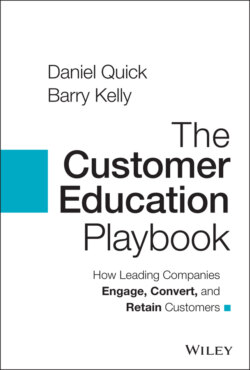Читать книгу The Customer Education Playbook - Daniel Quick - Страница 15
Academy
ОглавлениеThis is where you'll focus much of your efforts around learning. Customer academies can also be called universities or learning centers. They usually offer courses, videos, and activities that help customers onboard and quickly find value with your products. They do this in a way that's less about knowledge transference and more about deep learning that ultimately leads to behavioral change. Content could be self-paced, eLearning content, or tutorial videos – and sometimes you'll find blended training or virtual instructor-led training (VILT). Often, your academy will start with onboarding content to help your customer find value as quickly as possible. Later, you can supplement onboarding content with deeper or broader learning tracks that help your customers develop mastery with your products. You can even create a certification to demonstrate this proficiency. Eventually, you can expand your content strategy to continuing education, helping customers become experts – not only with your product, but also in their industry. For example, at Thought Industries, it isn't enough that we teach you how to use our platform. We also want to teach you how to create exceptional learning experiences so that the product becomes a canvas for your own customer education strategy.
How to Build and Staff Your Academy You'll definitely want an LMS to create and manage your academy – preferably one that specializes in customer learning. A lot of people make the mistake of only thinking about what they need right now, but you should look for one that scales with your program beyond your first year. It's a huge pain to rip out an LMS and replace it. Look for an LMS with customization options and ways to personalize content that's aligned with the different audiences in your customer base. As we said earlier, you need your customers to want to be here, so engagement and consumption-driving features are a must-have. Make sure that your LMS offers deep integration with other business tools, like ecommerce functionality so that you can charge for the content you're producing, the videoconferencing software you're using for VILT (such as Zoom), the CMS that you're using for your knowledge base, your customer relationship management (CRM) such as Salesforce, and your support ticket software. Don't settle for anything less than advanced reporting capabilities that provide a true understanding of the impact of your learning on the business. For the content that lives on your LMS, you'll find it a lot easier if you have native authoring tools available, but you can supplement these with video and audio editing software such as Camtasia and potential eLearning authoring software like Articulate or Captivate.
When you're thinking about how to staff your academy, look to hire instructional designers, sometimes called learning experience designers. These will be people who can create learning experiences optimized for learning transference. You may also want an academy program manager to holistically stay on top of the academy's progress and look for ways to expand and collaborate across the organization. As it's a different skillset, you might want to hire an LMS administrator who can handle the back-end technical configuration of the LMS itself. The content you want to include in your academy may also dictate what staff you need – for example, trainers for instructor-led training (ILT) or someone with experience in psychometrics for building exams or certifications.
